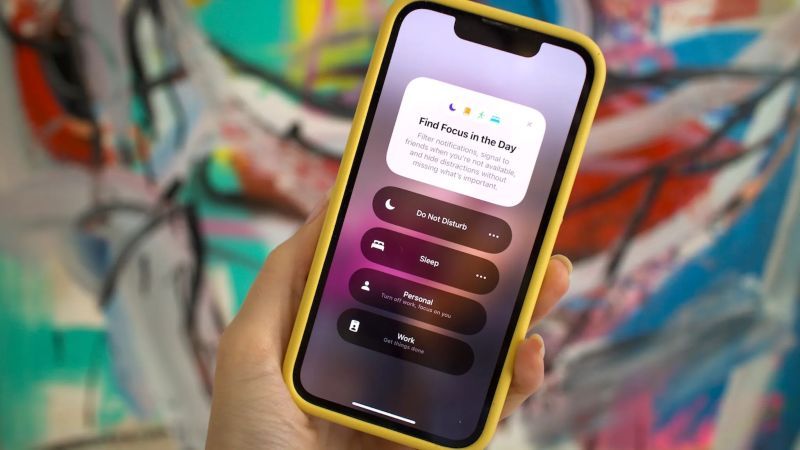

In today's fast-paced digital world, staying focused and productive can be a challenge, especially with the constant notifications and distractions from our smartphones. Let's explore this topic in more detail with Tiny Fishing, a popular mobile game that has captured the attention of millions. While games like Tiny Fishing can be entertaining, they can also hinder our productivity if we're not careful. Fortunately, Apple has introduced a powerful feature called Focus Mode for iPhone users, designed to help manage distractions and boost productivity. In this article, we'll dive deep into how you can harness the power of iPhone Focus Mode to stay on track and make the most of your time.
iPhone Focus Mode is a powerful tool introduced by Apple to help users manage their digital well-being and productivity. It's an evolution of the Do Not Disturb feature, offering more customization options and flexibility. Focus Mode allows you to create multiple profiles for different scenarios, such as work, personal time, or sleep, each with its own set of rules for notifications, app access, and home screen layout.
The beauty of Focus Mode lies in its ability to adapt to your lifestyle and preferences. Whether you're a busy professional trying to minimize distractions during work hours, a student aiming to concentrate on your studies, or simply someone looking to carve out some quiet time for yourself, Focus Mode can be tailored to meet your specific needs.
One of the key advantages of Focus Mode is its ability to filter notifications. You can choose which contacts and apps are allowed to break through your focus barrier, ensuring that you don't miss important messages or calls while blocking out less urgent interruptions. This level of control helps you stay connected to what matters most while reducing the noise that can derail your productivity.
Read more: Essential iPhone Security Tips to Keep Your Data Safe
Getting started with Focus Mode is straightforward, but it's worth taking the time to set it up properly to maximize its benefits. Here's a step-by-step guide to creating your first Focus Mode:
1. Open the Settings app on your iPhone and tap on "Focus."
2. You'll see some pre-configured Focus options like Do Not Disturb, Sleep, and Work. You can customize these or create a new one by tapping the "+" button.
3. Choose a name for your Focus Mode and select an icon. This helps you quickly identify and activate the right mode when needed.
4. Next, decide who can reach you when this Focus is active. You can allow calls from everyone, no one, or only specific contacts. You can also choose to allow repeated calls to come through, which is useful for emergencies.
5. Select which apps can send you notifications during this Focus. You might want to allow work-related apps during your Work focus, or meditation apps during a Personal focus.
6. Customize your home and lock screens for this Focus. You can hide notification badges and even create a specific home screen layout that only appears when this Focus is active.
7. Set up automation for your Focus. You can have it turn on automatically at certain times, when you arrive at specific locations, or when you open particular apps.
Remember, the key to an effective Focus Mode is customization. Take some time to think about what distractions you want to eliminate and what information you need to remain accessible. You can always refine your settings as you use the feature and discover what works best for you.
Once you've got the basics of Focus Mode down, there are several advanced techniques you can employ to further enhance your productivity and digital well-being:
One of the most powerful features of Focus Mode is the ability to share your status across devices and with other people. When you enable this option, your Focus status will be visible to others in messaging apps, letting them know that you're not available. This can help reduce the pressure to respond immediately and set clear boundaries for your time.
To set up Focus status sharing, go to Settings > Focus > Share Across Devices. You can also customize which Focus modes are shared by tapping on each mode and toggling "Share Focus Status."
iOS allows you to create custom home screens for each Focus mode. This means you can have a work-focused home screen with productivity apps front and center during your Work focus, and a more relaxed layout with entertainment apps during your Personal focus.
To set this up, activate your desired Focus mode, then press and hold on an empty area of your home screen. Tap the dots at the bottom to add a new page, then customize it with the apps and widgets you want to see during this Focus. You can hide existing pages by tapping the checkmarks below each page preview.
Focus Filters are a powerful way to customize how apps behave when a specific Focus is active. For example, you can set up a filter to only show work-related calendars and email accounts during your Work focus, reducing clutter and helping you stay on task.
To set up Focus Filters, go to Settings > Focus > [Your Focus] > Focus Filters. You can add filters for various system apps like Calendar, Mail, Messages, and Safari, as well as for supported third-party apps.
While you can manually activate Focus modes, setting up smart activation can help ensure you're always in the right Focus at the right time. You can set Focus modes to activate based on time, location, or when using certain apps.
For example, you might set your Work focus to activate automatically when you arrive at your office, or your Sleep focus to turn on when you plug in your phone to charge at night. To set this up, go to Settings > Focus > [Your Focus] > Add Schedule or Automation.
Read more: Best Features in iOS You May Have Missed
Now that we've covered the technical aspects of setting up and using Focus Mode, let's explore some strategies for leveraging this feature to boost your productivity and maintain a healthy work-life balance.
One of the primary benefits of Focus Mode is its ability to create a distraction-free work environment. By carefully curating which notifications can break through and which apps are accessible, you can significantly reduce the temptation to check social media or respond to non-urgent messages during your work hours.
Consider setting up a Work focus that only allows notifications from your team communication tools, work email, and perhaps a few key contacts. Hide social media apps and other potential distractions from your home screen during this focus. You might also want to enable Focus status sharing for this mode, letting colleagues know that you're in deep work mode and may not respond immediately.
While it's important to minimize distractions, it's equally crucial to remain accessible for truly important matters. This is where the customization options of Focus Mode really shine. You can set up your Focus modes to allow calls from specific contacts to break through, ensuring that you're reachable in case of emergencies or for high-priority communication.
For instance, you might allow calls from family members to come through during your Work focus, or permit notifications from your project management tool to ensure you don't miss critical updates. The key is finding the right balance between focus and accessibility that works for your specific needs and responsibilities.
Focus Mode isn't just about blocking distractions during work hours; it's also a powerful tool for protecting your personal time and maintaining a healthy work-life balance. Consider setting up a Personal focus that activates during your off-hours, blocking work-related notifications and highlighting apps for relaxation and entertainment.
You might also create a Family focus for quality time with loved ones, or a Fitness focus that activates when you start a workout, ensuring you stay in the zone without interruptions. By clearly delineating these different aspects of your life, you can be more present in each moment and reduce the stress of constant connectivity.
Focus Mode can be an excellent complement to popular productivity techniques. For instance, if you use the Pomodoro Technique (working in 25-minute focused bursts followed by short breaks), you could set up a Focus mode that activates for 25 minutes, then automatically deactivates for your 5-minute break.
Similarly, you could create a Deep Work focus for those times when you need extended periods